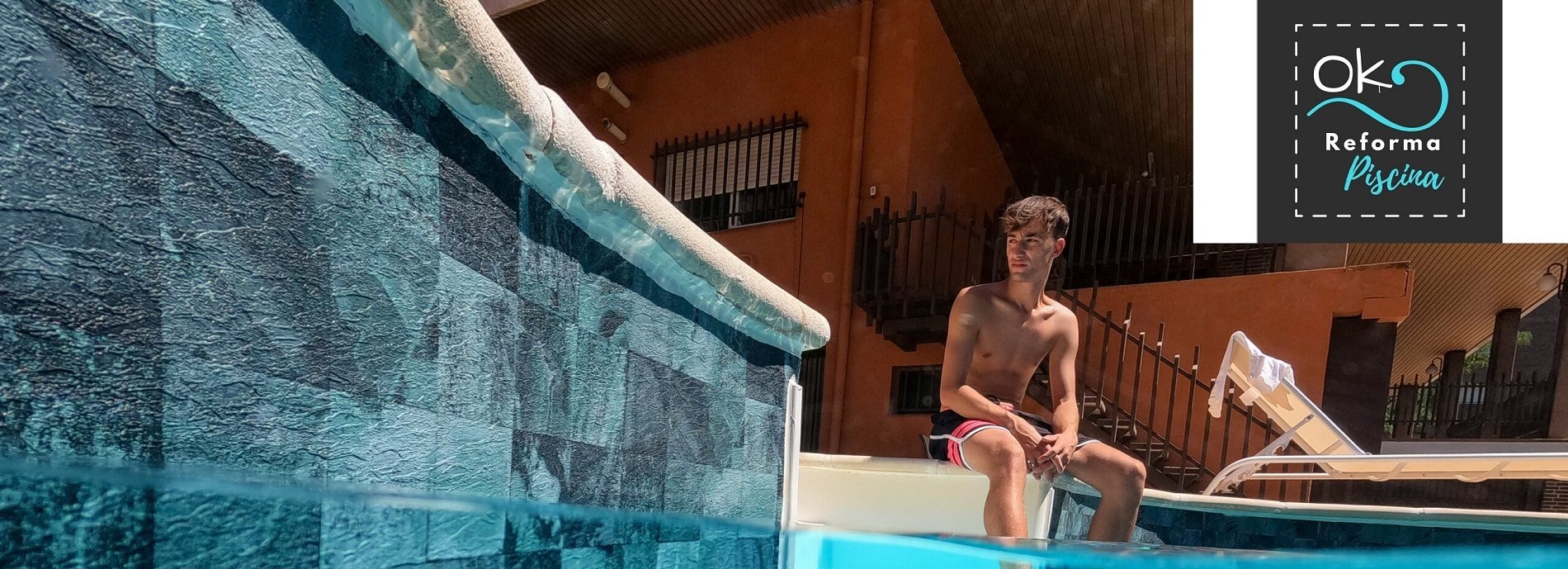
Table of contents of the page
In this entry of Ok Pool Reform we will tell you about one of the Aquagym variants, aquatic fitness aquarunning or otherwise said running inside the pool,
Aquarunning co chirp
Aquarunning what is it
Aqua-jogging what is it (aqua jogging / aquarunning)

What is aquarunning?
What is aquarunning
Aquarunning is a sport in which the training consists of a cardiovascular exercise that involves running or jogging in the water, either in contact with the floor of the pool in the shallowest part of the pool or in the deepest area. . Hence the person simulates the movement of running.
In general terms, Athletic training techniques are developed in aquarunning in a different environment than usual, which eliminates the burden that many exercises have outside the water achieving greater muscle activation due to the resistance that the medium offers to displacement and all movement.
Consequently, It is highly indicated for runners who want to combine their usual training plan with other techniques and who above all seek to minimize the impact on joints.
Necessary elements to exercise aquarunning fitness
In order to practice the discipline of aqua-running fitness, these elements are necessary:
- At the outset, we must have a pool glass depth convenient for playing sports.
- On the other hand, it requires a belt to be able to carry out the activity while floating (below this page you can find all the details about this product).
- As for the water shoes, they are not completely essential but according to our criteria we think they are necessary (you can find more information below this entry).
History of aqua-jogging

How aqua jogging became known
Aquarunning is a sport that was popularized in 2000 by Kelly Holmes.,
Why Kelly Holmes used the aquarunning technique
It should be remembered that the athlete in question, before winning her bronze in the Olympic Games, suffered an injury that prevented her from doing her medium-distance training, and for that reason she used aquarunning exercises.
Thus, He used aquajogging effectively to overcome the diagnosis and get fit for the world competition.
Holmes subsequently won two gold medals at Athens 2004 in the 800 and 1500 meters.
Thus, thanks to the contribution of Olympic athlete Kelly Holmes, aquarunning is a sport that has achieved great fans.
And, although aquarunning is a sport that had already been part of the training of many athletes, it was within the framework of the Sydney Olympics that aquajogging really came to light.
Running in the pool: What distance is it versus running on land?


Equivalences between aquajogging and running
Correspondence between aquajogg exercise and running
As you will hear in the episode, an exact equivalence between aquarunning discipline and running on dry land has not been found in the literature.
NOT ACCURATE correlation table between water jogging and running
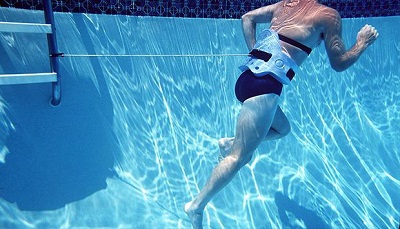
With the intention of being able to resolve the question raised about the correlation between running in water and on land, Luis, interested in measuring this, created an equivalence table based on his experience with aquajogging for more than 4 years:
60 – 70%: This is the gentle zone 2 type training.
- More or less every meter you do aquarunning in the pool is equivalent to 10 meters on land.
- For example: 1000 meters in a pool (40 25-meter pools) are equivalent to 10 kilometers on land.
70 – 90%: This is a workout similar to the effort you make in a long distance of 2172 minutes or more.
- In this case, each meter you do aquarunning discipline is equivalent to 11 meters on land. For example: 2125 meters in a pool (85 25-meter pools) are equivalent to 24 kilometers on land.
90 – 100%: This is a training similar to the effort you make in a speed session.
- . Every meter you do aquarunning in the pool is equivalent to 13 meters on land. For example: 600 meters in a pool (24 25-meter pools) are equivalent to 8 kilometers on a track.
Test of the relationship of distance from running in water to land

Next, this video shows a practitioner of the sport of running in the pool who was interested in knowing the consistency between running in the pool and running on land.
Well, he himself admits that he has never found a scientific formula that solves this own calculation.
Of isIn this way, the runner has based himself on several experiments to achieve a personal deduction: the distance he runs in the pool is equivalent to 8 or 9 times what he did on land.
Video of the distance to be equipped 100 meters in the pool vs running on land
What are the benefits of running and walking in water?
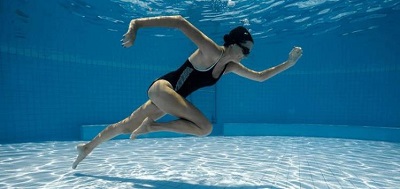
What benefits does aquarunning have?
First of all, we mention the advantages of aquarunning discipline in order to situate ourselves and later one of them will be described.
Aquarunning benefits
- Initially, aquarunning loses weight and burns a lot of kcal
- Helps intensify running technique
- Taking into account that it strengthens muscles
- It also helps to have better balance
- Improve cardiovascular condition
- Intensifies respiratory capacity
- Reduction in the possibility of joint and muscle injuries
- Convenient to deal with arthritis
- Excellent for trauma recovery therapy
- Therapeutic effect against anxieties, stress
1st Aquarunning benefits of running in water
Aquarunning loses weight

Aquarunning calories
Aqua running kcal
Aquarunning calories: You can burn between 300 and 500 calories in 45 minutes.
Race in the water
It is stipulated that 15 minutes of movement in the water is equivalent to 40 minutes of jogging out of it.
So that More calories are burned in less time and muscle tone increases. thanks to the resistance of water.
Moving in water represents 12 times more effort than that produced by air resistance.
Additionally, the vertical position in aqua jogging provides 4 times more resistance than the natural position when swimming.
Jogging in water helps burn calories and lose weight
In short, this is a cardiovascular exercise, the heart will begin to beat faster and pump more blood so that the muscles can face the challenge and this will help you burn calories, lose fat and stay in shape.
Aqua-running can eradicate overweight or obesity
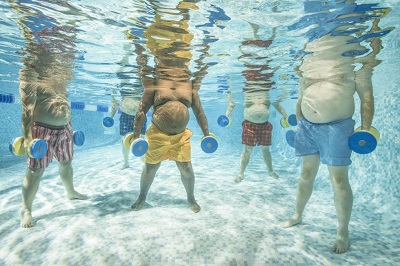
Another context where running in water is recommended is in weight loss programs due to:
- The absence of impact means a healthy activity for the joints of overweight people.
- La buoyancy in water facilitates the movements of these people in relation to dry activities.
- It is an activity in which the body of the practitioners remains underwater away from the eyes of other people, a circumstance that many people appreciate.
2nd Aquarunning benefits of running in water
Helps improve running technique

El aquarunning It allows specific training of an athlete, improving their cardiovascular capacity, while developing strength + resistance and avoiding impact on the joints.
Although aquarunning is a modality that any runner can incorporate into their training, it always has to be complementary. It cannot be taken as the only training for running.
Running in water can improve athletes' posture and running form
Likewise, the compressive forces supported by the intervertebral discs of the spine are significantly reduced in water.
For all these reasons, many athletes include this activity to continue improving their physical abilities while avoiding the burdens that a normal career entails.
3nd Aquarunning benefits of running in water
Tone and strengthen muscles in the water
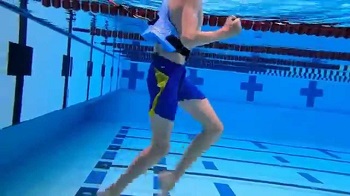
We manage to tone not only the legs, but also other parts of the body.
It is almost equivalent to exercising with weights in a gym, since as we have seen, water offers resistance and you have to use strength in your legs to be able to move forward. In this way, you are toning and strengthening an important group of muscles: abs, glutes, quadriceps, hamstrings, adductors, calves...
The joints are also strengthened since the movements performed underwater are friendly and respectful to them, avoiding the risk of injury.
Water relieves the stress of walking on land, avoiding the risk of trauma and providing a virtually safe environment. Plus, thanks to the resistance of the water, you get a massage and you don't have to carry your weight.
4nd Aquarunning benefits of running in water
Walking in water improves balance

Water is an unstable element, therefore, you will have to stabilize your body and maintain your balance while walking in this environment.
But the good thing in this case is that, if you fall, you will do so softly, without any pain or danger of injury.
5nd Aquarunning benefits of running in water
Maintains and improves your cardiovascular health

Great activity for blood circulation
This exercise is perfect for improving poor blood circulation since you are not only moving your extremities but you are getting a constant massage by doing the movements in the water.
In addition, hydrostatic pressure activates blood circulation, acting on peripheral veins and capillaries.
Because of the hydostatic pressure (how hard the water pushes against the walls of the pool) your heart will beat 10 to 15 beats less than doing the same effort outdoors.
6th benefits of running in water
Increases lung capacity

This exercise helps improve breathing, so lung capacity increases.
7th benefits of running in water
Reduction in the possibility of joint and muscle injuries

You avoid joint impact.
The impact that conventional running has on the joint is avoided, so injuries do not occur for this reason.
The buoyancy of the water takes pressure off joints such as the knee and hip, in addition to the buoyancy effect taking the load off the spine against the force of gravity, facilitating better overall movement.
8th benefits of running in water
Beneficial for people with arthritis

The buoyancy of water allows you to work in a safe environment, improves joint movement and reduces tension.
Arthritis is a disease that is accompanied by pain, stiffness and swelling of the joints.
In this case, it will be more beneficial to practice walking in the water of a heated pool, since hot water increases body temperature, blood vessels dilate and blood circulation increases, which can relieve pain.
In addition, it is advisable for people with arthritis to make slow and controlled movements.
9th benefits of running in water
Injury recovery and prevention

Builds strength and endurance: Excellent rehabilitation therapy, especially for professional runners overcoming injuries.
Aquarunning and injury rehabilitation
Injury rehabilitation is the area where water running has traditionally been used the most.
The main reason is that running in water is a non-impact activity in which normally the injury does not incapacitate the person to perform aquarunning.
It is ideal for recovering from sports injuries: It allows you to determine the intensity of the exercise
You are in charge, so you determine how hard you want to train. Therefore, it is a perfect exercise for older people who have not exercised for years, even if they do not know how to swim, since the exercise consists of walking in water, nothing more and nothing less.
Running without the natural impact of running on pavement. Ideal for runners in recovery.
You can set the pace yourself and adapt the intensity to your physical condition by setting yourself challenges to walk faster as you feel more confident or by increasing the time you practice this activity.
Aquajogg, strengthen and recover from injuries
Aquarunning as a recovery method
El aquarunning has proven to be a effective method to reduce or attenuate pain caused by bumps or strain compared to other activities
Another context where this type of training is used is as a recovery method after a match or competition.
Aquarunning in untrained people
El aquarunning It has been shown to be effective in improving some abilities in people with low physical condition.
- Increased cardiovascular capacity and force muscle of the upper and lower body.
- Regulation of hypertension in untrained people 60-75 years of age.
- Reduction of pain in people with fibromyalgia.
- Reduction of % body fat in obese people.
10th benefits of running in water
Walking in water helps you relax:

This activity is perfect to combat anxiety and tension accumulated throughout the day
, so it improves the mood. The water provides a massage effect on the body, which automatically provides a feeling of relaxation.
It is a very fun activity
Going to the gym, running or cycling can be understood by those who do not enjoy sports as just another task, and a sacrificial one at that. However
Walking through the water is a fun and simple activity, great for older adults since you can even go as a couple or in a group talking, just as you do while walking down the street.
- Aquarunning what is it
- Running in the pool: What distance is it versus running on land?
- What are the benefits of running and walking in water?
- Aquarunning disadvantages
- Necessary aquarunning material: Aquarunning belt
- 2nd Aquarunning material required: Aquarunning shoes
- Aquarunning technique
- How to run underwater?
- Aquarunning exercises
- What to do to make aquajogging more fun?
- Aquatic treadmill
- Gentle variant of aquarunning: Walking in the pool
- Music for aquarunning
Aquarunning disadvantages
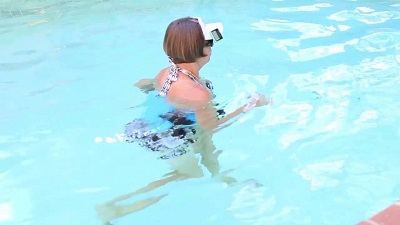
Contraindications of water jogging activity
Notify the teacher if we are in the recovery process
Never year However, the teacher must be informed of the existence of an injury or the need for rehabilitation.
Precautions for pregnant women when doing aquajogger
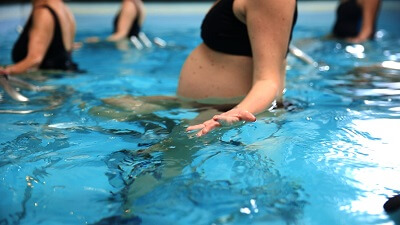
Actually, this aquatic activity is highly suggested for pregnant women, in short the limits of the exercise will depend on the possibilities of each one and will always be guided and marked by the professional technician who runs the jogging class.
Jogging disadvantages
Jogging has some disadvantages from a practical point of view
- After all, requires access to a swimming pool and adequate facilities, in addition to membership fees to access the training location, classes may cost additional.
- In the same way, there must be a space suitable for climatic conditions, with the possibility of playing music and consisting of safe facilities.
- Although water activities generally expend more energy than many surface activities performed at the same pace, due to the greater resistance of water, the speed with which movements can be performed is reduced considerably.
Small investment for aquarunning classes

- While It is also more expensive than other sports practiced outdoors, although it is usually affordable or included in the gym fee. At first, especially, you will feel a slight sensation of wanting to go faster than the water allows you.
- In conclusion, It is required to invest in certain specific aquarunning material such as a belt or aquatic shoes.
Necessary aquarunning material: Aquarunning belt
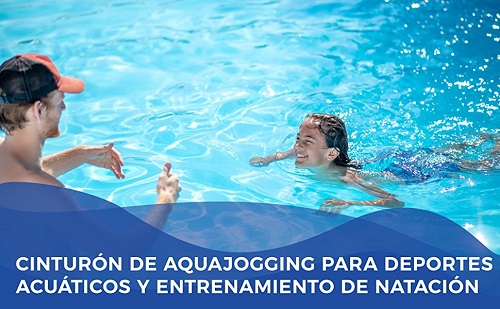
Necessary aqua-jogging equipment
Aquarunning belt for quality sports
Aquajogging Belt: Improve your performance and endurance with the jogging belt for water sports and swimming training.
First of all, the water jogging belt is the ideal support for water sports and exercises to improve mobility.
Also, use the belt to combine aquatic workouts with your regular workouts.
Additionally, it is worth mentioning that the aquatic belt easily adapts to your shape, regardless of your age or agility.
The belt provides momentum so that the body floats in the water and can adopt the correct, upright posture without further effort. An alternative is so-called leg floats: foam sleeves that are attached to the feet.
Finally, with aquatic exercises you improve resistance, strength and flexibility. This way, Use the belt to practice water aerobics, lose weight. to learn to swim with confidence or to help you in your exercises to improve motor skills.
Features aquatic jogging belt
Versatility
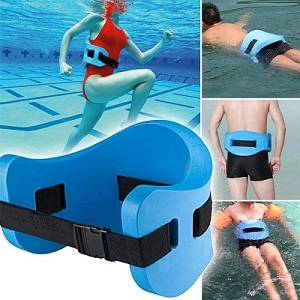
This belt is perfect for different purposes such as learning to swim, doing water sports, running in the water or even relaxing with a newspaper in the outdoor pool and floating effortlessly.
Optimal flotation
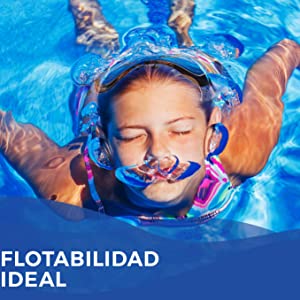
Thanks to the high-quality PE foam, buoyancy is optimal during water sports; the upper back has an additional supporting effect.
The water jogging belt has an ergonomic shape that is comfortable for the body.
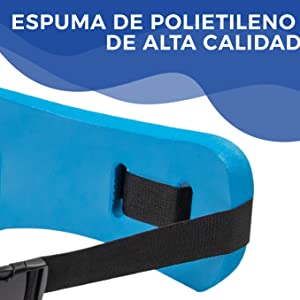
High quality PE foam is the ideal support for this type of activity. You won't have to worry about staying afloat.
The material and design of the aquajogging belt allow you to use it to the fullest without any motor limitations and always have optimal breathing control during exercise.
Adjust the belt to your needs

Fastening and unfastening the seat belt is quick and safe.
UNIVERSAL SIZE
Due to its universal size and adjustable strap, the swimming belt fits everyone weighing up to 100 kilograms.
How to put on the aquarunning belt

The Aquajogging belt is quick and easy to put on
- For starters, with the help of the secure snap closure and its innovative quick release, it is very easy to use.
- Thanks to its snap closure, putting it on only takes a moment.
- Put it around your waist and close it with a click.
- Now you can adjust the belt by pulling on the strap.
- Well, do this until the belt feels comfortable but secure. Simply adjust the waist size and enjoy your exercise in the water without worries.
How to properly use the aquajogging belt
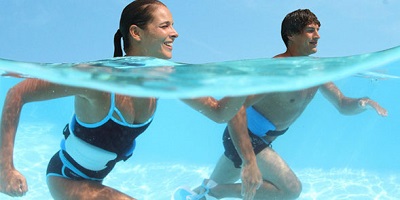
Ideal for your fitness exercises in the water: Use the aquajogging belt following some guidelines.
- Make sure the water you exercise in is deep enough so your feet don't touch it.
- Maintain an upright posture with your shoulders above your hips.
- When you do a series of exercises, take intervals to recover.
- Thanks to the PE foam belt, the exercises will not be as heavy as if you did them out of the water, however it is good to take breaks.
Operation of the aqua jogging belt
Operation of the aqua jogging belt
Buy aquarunning belt
Aquarunning belt price
EVEREST FITNESS Swimming Belt Water Sports and Training – Float Belt for Swimming and Adjustable for Aquajogging up to 100kg – Pool Bubble for Children and Adults
[amazon box= «B01ICXZED4 » button_text=»Buy» ]
Beco – Training belt for water sports
[amazon box= «B000PKDTBW » button_text=»Buy» ]
Speedo Unisex-Adult Belt
[amazon box= «B076VWTLNM » button_text=»Buy» ]
2nd Aquarunning material required: Aquarunning shoes

Cressi booties

History of Cressi pool slippers
The Cressi experience was born in 1939 thanks to the brothers Edigio and Nanni, passionate about the sea and with an innate predisposition to design and manufacture prototypes. Thus he began the artisanal manufacture of the first masks and underwater rifles. In 1946, their products became so well known that they founded the current Cressi in Genoa. Since then, the family business develops, designs and produces sporting goods that it markets throughout the world.
Cressi Reef Boots

Peculiarities Cressi Water Shoes pool slippers
Cressi Water Shoes are a wrap slippers Made of a soft, elastic and light material. Designer sole antiskid, shovel perforated on almost its entire surface and reinforcements in the toe and heel. Very comfortable for swimming pools, boats and breakwaters, they are also ideal to take on a trip.
- Made of a soft, elastic and light material
- Anti-slip sole
- perforated shovel
- Very comfortable for swimming pools, boats and breakwaters
- Ideal for travel
About Cressi eef water shoes
 |  |  |  |
|---|---|---|---|
| Wrap-around sneakers made in a soft, elastic and light material. Perfect for swimming pools, boats and breakwaters. | The shovel is perforated on almost its entire surface, allowing air to pass through and water to escape. | Adherent to the ground thanks to the resistant sole y antiskid. | Practical and light, with the reinforced toe and heel to protect the feet, they are ideal to take on a trip. |
Cressi Reef Boots

Special Features of Cressi Reef Boots
Cressi Reef water shoes review

Details Cressi Reef aquatic shoes
 | 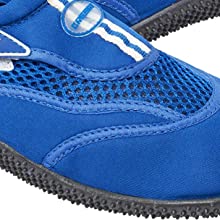 | 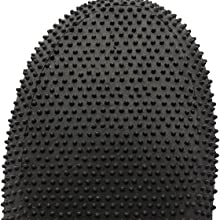 |  |
|---|---|---|---|
| For all types of water sports Shoes ideal for all types of water sports, allowing you to use them in the water, on the beach or on the rocks. | High quality materials It combines light 1.5 mm neoprene panels with breathable areas in semi-flexible mesh. | 100% non-slip Resistant and 100% non-slip on all types of surfaces, dry or wet. | Velcro closure Velcro closure system for greater support. |
Cressi 1946 booties

Characteristics Cressi 1946 Boots
The Cressi Aqua Shoes 1946 sneakers are light, ideal for free time and suitable for walking on the street, near water and in water. They protect the feet of hot sand, stones, sea urchins, rocky areas and rugged bottoms. They can be used with bare feet. La shovel It is made of reticulated fabric, so it dries quickly and allows the foot to breathe. The sole is perforated so that the water comes out and the foot dries.
- Ideal for walking on dry ground and in water
- Waffle fabric upper
- Flexible and perforated sole so that water runs out and the foot dries
- Available in different bright colors
Cressi 1946 pool slippers specification
 |  |  |  |
|---|---|---|---|
| The sole is perforated so that the water comes out and the foot dries. In this way, the foot can breathe more easily compared to other common water shoes. | La shovel It is made of fabric reticulated, so they dry quickly and allow the foot to breathe. This solution maintains the ventilated foot even on the hottest days of summer. | ¡Elastic bands no need to tie! These bands close over the instep, adapting to any type of collar, while the varnished metal eyeletsThey give a special finish to the shoe. | The fabric buttress with the Cressi logo features a handle on top that can be used as an aid when carrying. put on the shoe. |
Cressi booties reviews
Video review of Cressi booties
Next, in this video they present the Cressi 1946 Aqua Shoes Sports Shoes for Aquatic Use, Very comfortable and breathable
Aquarunning technique

Aqua-running discipline
Practice aquarunning fitness
To practice walking or walking in the water you only have to insert a part of your body into it and simply walk. You can also run or walk backwards. Fresh water activates blood circulation and promotes better venous return and in salt water we benefit from the mineral salts and trace elements it contains.
Aquarunning characteristics: Considerations for practicing the pool sport

Where is aquarunning practiced?
In what water to do the aquajogg
It can be practiced both in the pool - even with devices designed to run in the water - and in the sea.
This specialty is booming thanks to its low impact and its benefits for recovering from injuries.
When can you practice water jogging
Aquajogg: It can be practiced in summer or even in winter
with a wetsuit, in addition, in water at 12 or 13 ° C, more calories are burned. In short, water is an excellent training tool since it instantly adjusts to the force you exert on it, it provides resistance in all directions and this is good for:
Differences between the type of water in which we practice aquajogg

Training inequalities depending on what water we walk in
- Fresh water activates blood circulation and promotes better venous return.
- On the other hand, salt water benefits from the mineral salts and trace elements it contains.
- Furthermore, in water at 12 or 13 ° C, more calories are burned.
How to move to do aquajogging?
Correct posture of aquarunning

The objective of the activity is to simulate surface running.
With the flotation problem solved by the belt, the person has to position the body and move in the following way:
- The body is found slightly inclined forward. It is very important to maintain a straight posture with the shoulders just perpendicular to the hips. Most people who have been observed underwater lean forward a lot. Obviously buoyancy affects this ability to stay upright.
- The head is out of the water and the look forward (not down).
- The hands are relaxed without pushing or pushing the water with them.
- Close your hands slightly like when you are running. Not only does this mimic good running technique, it prevents you from cheating and swimming instead of running in the water. Don't use your hands as oars.
- The elbows are flexed 90º.
- El arm stroke is done from the shoulders.
- Imagine that you are jumping over a barrel of wine and that you are pushing them back. The idea is to really exaggerate the movement of your knees when you go up and to stretch your back leg well.
- Perform dorsiflexion with your feet. Although you don't consciously do it on land, when you run your toes point a little towards your shins. Strive to maintain this natural running movement.
- The hip is flexed 70º at the same time the knee also flexes. In the leg stretching movement, the hip extends 5º while the knee extends completely.
- The ankles also perform dorsiflexion and plantarflexion movements along with the knee and hip.
Position for water jogging training

Appropriate posture to exercise aquarunning in the pool
When running underwater, the body should remain as vertical as possible, avoiding the tilt of the chest forward and maintaining the coordinated movement of arms and legs similar to the movement they perform when running on dry land.
To walk in water, the height of the water is important.
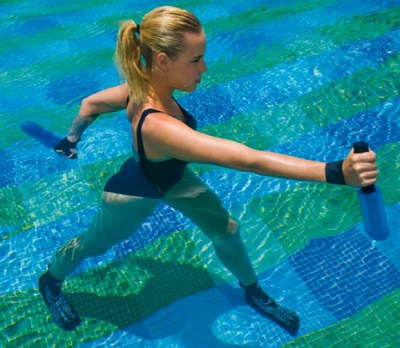
Importance of the height of the water for training in the aquarunning discipline
The higher the water altitude, the more resistance it will make us.
It is most advisable that the height of the water does not exceed the person's waist. It is important to avoid walking on tiptoe and keep your back straight.
Force applied for aquarunning discipline according to water level
Comparison of force used when running on land vs running in water

Aquarunning techniques

There are two techniques to run underwater
First of all, it should be noted that both techniques make the body work in a similar way and require the same mechanics.
- First of all, there is the aquarunning technique in which you run in water up to your waist in which you run with your feet resting on the bottom of the pool.
- And, secondly, you have another method in which the runner is immersed enough in the water that his feet fail to touch the bottom of the pool. In this second technique, runners replicate the movement of running by staying in the same place or moving slowly forward.
Technique to correctly practice aqua-running
Part of a good workout includes active and passive recovery sessions. Both are very important for correct adaptation, better performance on race day and injury prevention.
Aqua-jogging or running in the water provides an excellent option for an active recovery session.
It can even replace ground training if you are experiencing an injury that is aggravated by impact.
Aquarunning technical video
Next, the video shows the technique and gesture of running underwater.
Aquajogging variables

Three variables are recognized as aquajogging:
1st aquarruning variable: Zero impact
- In the first instance, we have the zero-impact aquajogging modality, which consists of Run with a flotation band in water deeper than your height.
2nd variable aquarruning: 80% impact
- Simultaneously, there is also the option of 80% impact which lies in running or walking in the pool touching the bottom.
3rd aquarruning variable: Submersible band:
- Lastly, there is also a third type of aquajogging, in which a submersible band is used to be able to submerge.
How to increase resistance in aquajogg
How to increase the resistance strength level of the exercise
How to increase the strength level of the exercise
In parallel, the hands and arms can move through the water, another option is the use of hand cloths or other devices to increase resistance.
Proper rubber footwear is highly advisable to help maintain traction at the bottom of the pool.
Aqua-running fitness intensity
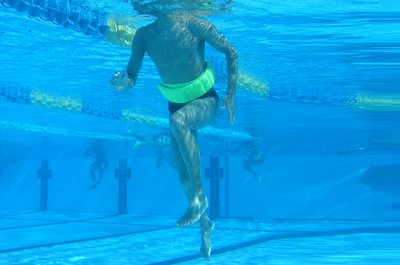
Controlling the intensity of exercise means measuring heart rate.
However, not recommended to use this parameter since due to the effects derived from hydrostatic pressure, heart rate in water drops between 10 and 17 beats per minute.
Therefore, it is very difficult to guarantee that the exercise intensity is appropriate for the training objective through heart rate (4).
On the other hand, variables such as cadence or range of perceived exertion (RPE) have proven to be reliable for measuring intensity in aquarunning.
Next, the specific RPE scale for the aquarunning created by David K. Brennan:
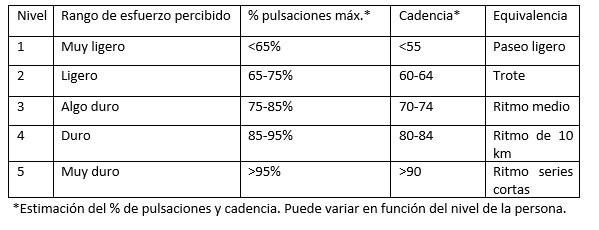
- Aquarunning what is it
- Running in the pool: What distance is it versus running on land?
- What are the benefits of running and walking in water?
- Aquarunning disadvantages
- Necessary aquarunning material: Aquarunning belt
- 2nd Aquarunning material required: Aquarunning shoes
- Aquarunning technique
- How to run underwater?
- Aquarunning exercises
- What to do to make aquajogging more fun?
- Aquatic treadmill
- Gentle variant of aquarunning: Walking in the pool
- Music for aquarunning
How to run underwater?

What type of workouts and what is it like to run underwater?
How to do aquarunning?
Everything you do on dry land can be duplicated in the water. From very gentle zone 2 workouts to speed intervals. We recommend that you study the previous equivalences, and adjust them to your personal abilities. However, you can do all the types of workouts that are included in a normal plan, except perhaps for hills.
- Long speed sessions (tempo run).
- Zone 2 or regenerative training.
- Funds longer than 90 minutes.
- Short speed sessions.
- Intervals
As practiced?
Running training in the pool
The movement should preferably be performed in the deepest part of the pool. In any case, the important thing is be suspended to give free mobility to the legs, without touching the bottom with your feet. This in turn gives the possibility of expanding the alternatives in different warming activities.
In order to hold on and stay afloat, it is necessary to maintain a correct body position. The head, neck and shoulders must be out of the water, and the rest of the body inside it, trying to remain with the trunk upright.
To achieve this position, use lifejacket, abdominal floats or foam belt. However, there are also submersible treadmills, which can provide greater reliability in water and an established training pace.
The arms and legs should be given the same movement that is made when running, with cyclical gestures, maintaining similarity in body posture with the common trot, always forward with the head raised.
The routine plan will depend on the physical conditions in which it begins and the safety and skills that are acquired inside the pool. In general, 4 or 5 series can be done, alternating periods of execution with rest, or with low or high intensities.
Like all training, it requires a prior warm-up and some lower intensity exercises at the end.
How to do aquarunning aquatic fitness

Procedure for good practice of aquarunning aquatic fitness
- To begin with, at the beginning of the activity, it is suggested to warm up by doing some lengths.
- Maintain a straight posture with your shoulders just perpendicular to your hips.
- Close your hands subtly when you're running.
- Exaggerate the movement of your knees when you go up and stretch your back leg well.
- Perform dorsiflexion with your feet. When you run your toes point a little towards your shins, so try not to forget this natural movement of running.
- Then, we will start running at different tempos, more or less fast, for a minimum training of 45 minutes.
- Finally, comment that when running underwater you can use a flotation belt, recommended for beginners until they feel comfortable in the water to progress to running without the belt.
Aquarunning exercises

The exercises that are mainly practiced in aquarunning are movements.
A first aspect of the exercises that are mostly carried out with aqua running fitness is that they can be done from skipping up and back to variations of different steps such as long and short strides, short steps, trot step, soldier step, etc.
Although, in some phases we can introduce specific exercises such as Fartlek that improve cardiovascular efficiency and those that also involve the upper body or those that help with the stabilization and balance of the pelvic girdle or core.
Likewise, lumbar and abdominal work is also essential for correct running posture.
Types of aquajogging exercises
Exercise prototypes for running in water
- Jumps: Bringing your knees to your chest in the water stiffens your legs and buttocks. You can vary the jumps and do them by opening and closing your legs, with one leg or with your feet together, in different directions... always taking advantage of the little impact of water on bones and joints and, therefore, the lower risk of injury.
- Kicks: Keeping your back straight and your abdomen firm, you kick in different directions, front, side and even backwards, to tighten your glutes and gain muscle tone and strength in your hips and belly. An alternative way to burn abdominal and leg fat.
Aquarunning training plan

Exercises to do in the aquarunning workout
- To start you always have to do a warm-up, 10 or 15 minutes.
- Time: Run at medium intensity for 5 minutes and rest for 1 or 2 minutes. Do it more than twice.
- Regularity: You don't have to jump into the water and start running like crazy. The important thing is that you distribute the exercise over 30 to 45 minutes so that you can maintain the pace that your body asks of you.
- In the center of the deepest area (away from the edges), extend your arms in a cross and stretch your legs: one forward and one back. Quickly, bring your arms close to your body and stretch your legs together.
- Repeat the exercise alternating legs. Stepping on the bottom with one foot and resting one hand on the edge, place your body parallel to the wall.
- Bring the other leg forward, backward and spread it perpendicularly as far as possible. Then change legs.
Aquarunning exercise table

A good aquarunning workout
- 5 minutes of joint mobility out of the water.
- 5 minutes of heating in water.
- 35 minutes of running in the water, whatever the style.
- 15 minutes of easy rhythm.
- 10 minutes of specific exercise (can be of any type).
- 10 minutes of decreasing rhythm to relax.
- 5 minutes releasing with much slower movements.
Long duration training
The structure of a long-term training for people who have good technique and adequate physical condition could be like this (2):
- Training 1 (total duration 35 min.):
- 8 min. at level 2 (Brennan scale).
- 7 min. at level 3.
- 6 min. at level 3.
- 5 min. at level 3.
- 4 min. at level 3.
- 3 min. at level 3-4
- 2 sets of 1 min. at level 4-5.
- Training 2 (duration 25 min.)
- 1 series of 10 minutes at level 3 (Brennan scale).
- 1 series of 10 minutes at level 3-4.
- 1 series of 5 minutes at level 4.
Aquarunning routine: series interval training
In the water it is also possible to carry out high intensity training (2):
- 32 min training.
- 10 sets of 1:30 min. at level 3-4 (Brennan scale).
- 10 sets of 1 min. at level 3-4.
- 10 sets of 45 seconds at level 4-5.
Aquarunning session
Aqua running class video and aquarunning exercises + swimming
We are going to do a high intensity routine in the pool.
Combining Aqua jogging with Swimming, speed EXERCISE ROUTINE
1. BUTTERFLY You can do: a) 25 meters at your fastest speed b) 40 seconds to 1 minute
2. Run in the pool, you can do it with a sandbag on your shoulders. 1 minute at maximum
3. BACK a) 25 or 50m b) 40 sec to 1 minute
4. Run 1 minute at maximum, carrying the bag on the right side
5. Freestyle or crawl a) 25 or 50m at maximum b) 40 seconds or 1 minute
6. Run 1 minute at maximum, carrying the bag on the left side
7. Chest a) 25 or 50m at maximum b) 40 seconds or 1 minute
Aqua Jogging and Swimming Routine Video to burn fat!
Aquarunning class
Aquarunning exercises to run faster or for strengthening and injury recovery
To start, imitate running movements.
Once positioned correctly, we will continue making the movements that we need to do when we run on a stable surface. Your mouth should be far enough above the water without having to tilt your head back and be able to breathe normally. The head should look forward instead of down. The body is slightly forward, without making the mistake of leaning too much. Keep your spine neutral. The arm movement is exactly the same as on the surface. We will move our legs in a lunge position, bending our hips about 60-80 degrees. Although our movements are more or less abrupt, we barely move, we will remain in a stable position throughout the exercise and we will need little space.
Running pool exercises to improve posture when running
Aqua-jogging: Two exercises to improve posture when running
Next, in this video we explain 2 things you can practice in the pool to improve your posture when running. Obviously you don't have to do it in the pool, these two basic things are things you can do on land. The first is to remember to have your hand fists relaxed and not completely closed. That stiffness causes stress in the neck and makes you run very tense, wasting energy unnecessarily. The second is to get used to taking a stroke from front to back. Some people cross their arms in front of their chest in an exaggerated manner. This doesn't help you run better. It is better, according to experts, to imagine that you would like to hit someone behind you with your elbows. Now, it's not about doing each stroke with exaggerated force backwards. The movement should be smooth and natural.SHOW LESS
Running pool to improve posture when running
What to do to make aquajogging more fun?
We confess that this activity can be somewhat boring. You will most certainly be the slowest person in the pool and time passes very slowly when you go from one side to the other. To handle this we suggest:
- Get a waterproof iPod or Bluetooth headphones that can sync over 100 meters (Bluetooth 5.0)
- Tie an elastic band / bungee cord that the sprinters They use the flotation belt and try to run in the water further and further and holding the resistance for more and more seconds.
- Get a training partner.
- Play with your mind. Beat your # of laps in an hour, your fastest lap, etc.
- Remember the reason why you decided to do aquajogging in the first place.
Aquatic treadmill

1st model of aquatic treadmill
Waterflex AquaJogg Underwater Treadmill
"easy push" opening system

Opening: Push the lever and let the platform lower to the ground. Simple and effortless.
Closing: hold the lever and lift the platform with your foot. Listen for the tape to click to make sure it has closed properly.
Features of aquatic treadmill
Material: 100% AISI 316L stainless steel
· Finish: polished steel with anticorrosive treatment
· Mechanism: folding treadmill
· Tape: Running surface 38 x 118 cm. Incline 13%
· Wheels: Ball bearing on anti-scratch white wheels, easy movement
· Stability: White skates for stability and anti-scratch protection
· Coating: Suitable for all coatings (PVC, tiles, polyester, etc…)
· Weight: 32 kg
· Dimensions: L.67 x l. 135 x H. 128 cm (max)
· Folded dimensions: L. 56 x l. 62 x H. 128 cm (max)
· Depth: 0.90 m to 1.50 m
Waterflex underwater pool treadmill notice
Waterflex products are suitable for all pools whose PH is between 7.0 and 7.4.
· The products must be removed from the pool when a specific treatment is carried out.
· They cannot be installed near the ejection nozzles
· Products must be removed from the pool and cleaned with clear water after each use.
Operation Poolstar Aquajogg Waterflex underwater pool treadmill
How the Poolstar Aquajogg Waterflex pool treadmill works
Treadmill Price for Fitness in the water
Waterflex AquaJogg – Treadmill for Fitness
[amazon box= «B007JUGLX4 » button_text=»Buy» ]
2nd model of aquatic treadmill
Aquajogg Air pool walking mat

Waterflex – Swimming pool walk mat
The Aquajogg Air mat is the first to use an anodized aluminum structure as well as removable support bars. Work on muscle strengthening at your own pace, resistance and rehabilitation safely with excellent stability. AquaJogg is designed for daily and intensive use in group or individual courses. Can be used barefoot. The innovative folding system gives it a little space and the silicone wheels facilitate the entry of water without marking the floor.
Waterproof.

Expert in aquavitality, Waterflex is committed as a companion to your shape.
Since its inception, Waterflex has been committed to making aquatic fitness accessible to everyone.
Its objective is to offer a complete range of quality products to meet the demands of professionals.
In the heart of Provence, between ancestral tradition and innovation, Waterflex was created. A young dynamic entity in full swing, driven by the creativity and experience of its leaders' pool team.
Pool Walk Mat Tape Price
Waterflex – Aquajogg Air swimming pool walking mat 128x67x135 cm Poolstar WX-AQUAJOGG2, assorted color/model
[amazon box= «B07R8GX9G8 » button_text=»Buy» ]
Gentle variant of aquarunning: Walking in the pool

What is walking in the pool?
What does it mean to walk in the pool?
EThe aquatic exercise of walking in the pool is, as its name indicates, a low-impact activity that consists of walking in the pool.
Actually, walking in water reduces the pressure on bones, joints and muscles.
Additionally, water offers natural resistance, which helps strengthen muscles.
Who is walking in the water for?
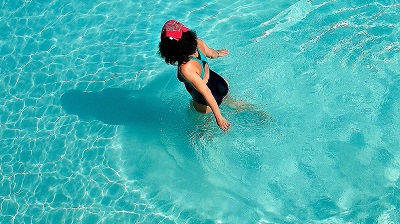
Public suitable for walking in the pool
Walking in water, whether in the pool or the sea, is a perfect aerobic exercise for people of all types of conditions..
That is to say, the pool sport of walking inside is adapted to all audiences.
In consecuense, It is ready for older people who do not usually practice any sport to the youngest people.
In fact, the practice is increasingly mIt is recommended for elderly people who have suffered some muscle, joint or bone damage.
Walking in the pool benefits
Walking in the pool loses weight
- It is necessary to emphasize that walking in the pool strengthens the heart.
- Lowers blood pressure.
- Another feature of walking in the pool is good for circulation
- You burn calories and maintain useful weight control.
- Another aspect is that it helps regulate glucose.
- Tone and strengthen muscles in the water
- Walking in water improves balance
- It is very beneficial for people with arthritis to practice walking in the water of a heated pool,
- Finally, walking in water is a perfect activity to combat anxiety and accumulated tension.
How to walk in a pool?

You can walk slow or walk fast, By increasing speed, you increase the intensity of the workout.
When you practice this activity, you will find that you have to overcome water resistance, and the fact is that water offers a resistance proportional to the effort exerted against it.
Walking on the ground is highly beneficial but, if you also do it on water, you will be working your muscles and joints more since the resistance of water varies between 4 and 42 times more than air, it all depends on the speed of the movement you perform. . The faster you walk through the water, the more resistance you will encounter.
How to walk in water
- To walk in water, the height at which the water is is important. The higher it is, the more resistance it will cause. It is most advisable that the height of the water does not exceed the person's waist. It is important to avoid walking on tiptoe. foot, and keep your back straight.
- With the water up to your waist, walk from one end of the pool to the other, taking steps forward and then backward for 2 minutes, to activate and warm up your body.
- Increase speed to increase training intensity at random intervals.
- Also use your hands to exercise the muscles in your arms. You just have to put your hands under the water and swing them back and forth, like when you walk.
- You can use a water weight to hold in your hands while you walk.
- Try to practice this activity for at least 20 minutes without stopping, two or three times a week. Add time and intensity as it becomes easy for you.
Tips for walking in the pool
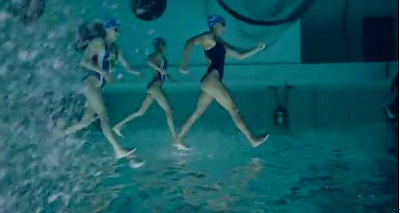
If you really want to take advantage of this training, you have to do some routines:
- Firstly, change your speed and intensity at random intervals, that is, take a couple of walks around the pool at a slow and leisurely pace to take three walks at a fast pace and with more resistance in the water. This way you will train your muscles better and you will be strengthening your heart, in addition to, of course, burning more fat.
- Also use your hands to exercise the muscles of the arms. You can even do it with neoprene pool gloves to intensify the exercises and work your upper body even more. You just have to put your hands under the water and swing them back and forth, like when you walk.
- Above all, remember that you can also use some suitable pool shoes if you want to protect your feet. As well as a loose t-shirt and shorts to create more resistance. This way you will train harder.
- Likewise, if you've been doing this activity for a while and notice that it's become easy, it's time to pick up the pace or add resistance. Can use a weight of water to hold it with your hands while you walk.
- Finally, try to practice this activity for at least 20 minutes without stopping, two or three times a week. Add time and intensity as it becomes easy for you.
